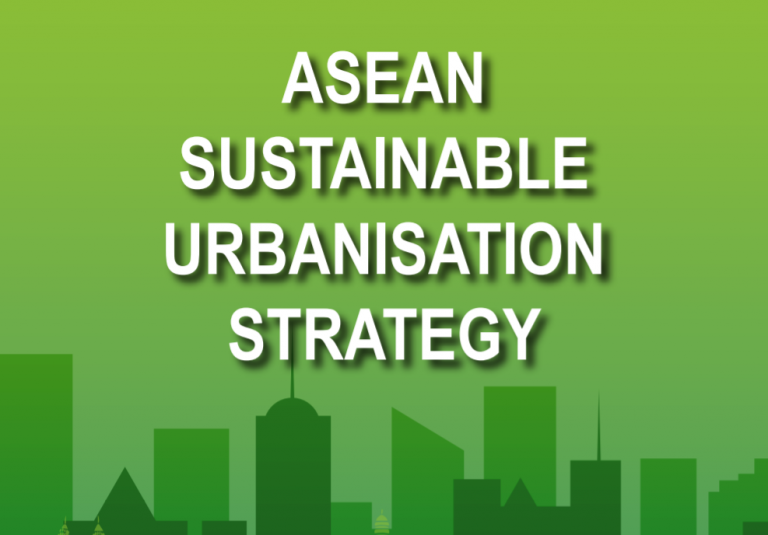Chiến lược đô thị hóa bền vững ASEANJOINT STATEMENT BY THE CHAIRS OF THE ASEAN CONNECTIVITY COORDINATING COMMITTEE AND THE LEAD IMPLEMENTING BODY FOR SUSTAINABLE INFRASTRUCTURE Today, half of all people in ASEAN live in urban areas and an additional 70 million people are forecast to live in ASEAN cities by 2025. Economic growth is occurring at a rapid pace not only in mega-cities such as Jakarta, Manila and Bangkok, but increasingly in middleweight cities, with populations between 500,000 and five million. Urbanisation is a crucial driver of economic growth. No country has yet achieved middleincome status without a significant shift of its population into cities. The underlying causes include the benefits of economy of scale for larger cities, as well as the higher wages that people typically receive as they transition from an agrarian to an urban society. The immediate need for cities in ASEAN is to provide adequate and sustainable urban infrastructure to meet the increasing pace of urbanisation. In the process of meeting infrastructure demands, smart urbanization applications could potentially provide a way for cities to leapfrog in technology and facilitate optimal use of existing infrastructure. However, urbanisation also poses challenges related to inclusiveness (particularly housing), environmental pollution, economic efficiency (linked to rising traffic congestion), health and cultural heritage. While presenting opportunities for women and girls that are often unavailable in rural settings, urbanisation can also cause them to seek work in the informal sector, contributing to income disparity and increased risk, including from violent crime. These challenges can be amplified by rapid and haphazard urbanisation, which has occurred in many ASEAN countries. These challenges must be addressed in order to achieve sustainable urbanisation. Cities need to develop strategies to sustain the momentum of economic activities, provision of housing, healthcare, education, energy services, and mitigate the impacts of climate change, as well as manage various other priorities. The ASEAN Connectivity Coordinating Committee (ACCC), comprising the Committee of Permanent Representatives to ASEAN, has been tasked by ASEAN Leaders to facilitate the implementation of the MPAC 2025. There are several linkages between sustainable urbanisation and ASEAN Connectivity: 1. ASEAN will only realise true ASEAN Connectivity if cities are able to respond effectively to the negative effects of urbanisation. For example, tackling traffic congestion is essential to supporting connectivity of people, goods, and services. 2. ASEAN cities play a critical role in the realisation of the ASEAN Economic Community, where ASEAN Connectivity is a critical enabler, that helps to expand and improve production and distribution networks in ASEAN. 3. Given that ASEAN cities have evolved differently and at very different paces, there is an opportunity for ASEAN cities to leverage each other’s comparative advantages and experiences to overcome the challenges of urbanisation. Connecting cities will enhance cities’ efforts coordinate and develop their own customised urbanisation strategies. The Lead Implementing Body for Sustainable Infrastructure (LIB-SI) was established to coordinate the implementation of Sustainable Infrastructure under MPAC 2025. The development of an ASEAN Sustainable Urbanisation Strategy (ASUS), one of the initiatives under the MPAC 2025 Strategic Area of Sustainable Infrastructure, will support and improve the effectiveness of various ASEAN city networks, including the ASEAN Smart Cities Network (ASCN), the ASEAN Sustainable Development Goals (SDG) Frontrunner vi Cities Programme, ASEAN Mayors Forum, and various other city networks in ASEAN, such as those operating under the Brunei Darussalam-Indonesia-Malaysia-Philippines – East ASEAN Growth Area (BIMP-EAGA), and the Indonesia-Malaysia-Thailand – Growth Triangle (IMT-GT). A large number of cities in each of these networks share common priorities and concerns, and the ASUS aims to propose solution to these shared concerns to improve the effectiveness of these networks. ‘Toolkits’ will be provided to assist cities prioritise areas of focus related to sustainable urbanisation, and to develop high quality action plans in specific areas, which can be customised to the local city context. The ASEAN Vision 2020, adopted by the ASEAN Leaders on the 30th Anniversary of ASEAN, envisages ASEAN as a Community of Southeast Asian nations, outward looking, living in peace, stability and prosperity, bonded together in partnership in dynamic development and in a community of caring societies. The ASUS will play an important role in helping ASEAN achieve this vision and enhancing connectivity in the region.


